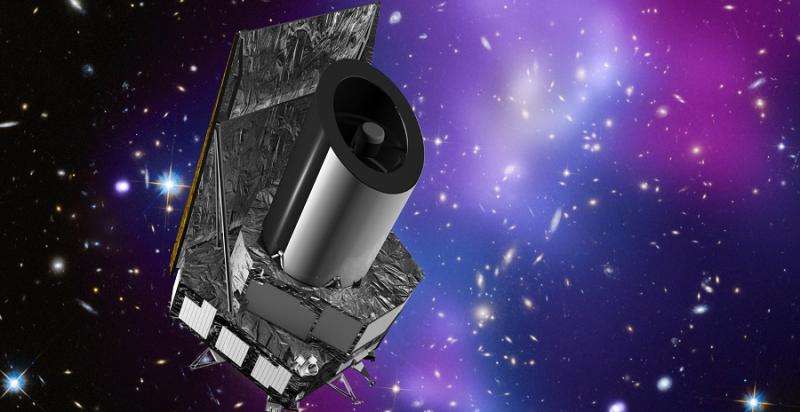Measuring the acceleration of the universe with the Euclid spacecraft

Dark matter and dark energy are two of the greatest mysteries of the universe, still perplexing scientists worldwide. Solving these scientific conundrums may require a comprehensive approach in which theories, computations and ground-based observations are complemented by a fleet of spacecraft studying the dark universe. One of the space missions that could be essential to our understanding of these mysteries is European Space Agency's (ESA) Euclid probe, designed to unveil the secrets of dark energy and dark matter by accurately measuring the acceleration of the universe.
"Euclid is designed primarily to help us understand the properties of dark energy. However, in doing so, it will utilize the exquisite precision only available to a space-based instrument to make measurements of dark matter over an unprecedented area of the sky. Thus, it will be a real breakthrough in our understanding of both dark matter and dark energy," Ulf Israelsson, NASA Euclid project manager, told Astrowatch.net.
The spacecraft is currently in the construction phase after successfully passing its Preliminary Design Review in the Fall of 2015. It will be launched in 2020 on a Soyuz rocket from Europe's Spaceport in Kourou, French Guiana. After liftoff it will be sent into orbit around the sun-Earth L2 point located approximately 1.5 million km from our planet.
In order to help us understand dark matter and dark energy, Euclid will employ two primary scientific methods.
"The first is weak gravitational lensing, whereby the apparent shapes of background galaxies are distorted by foreground dark matter. The second is galaxy clustering, looking at the three-dimensional distribution of galaxies," Jason Rhodes, NASA Euclid Deputy Project Scientist and the U.S. Science Lead for Euclid, told SpaceFlight Insider.
The spacecraft will map the shapes, positions and movements of two billion galaxies, delivering astronomers a vast set of important data for further studies. It is expected to produce numerous deep images and spectra over at least half of the entire sky.
To achieve its ambitious scientific goals, Euclid will be equipped with two main instruments: the Visible Imaging Instrument (VIS) and the Near Infrared Spectrometer and Photometer (NISP). These large format cameras will be used to characterize the morphometric, photometric and spectroscopic properties of galaxies.
"Euclid will have two instruments. The first is the visible imaging instrument. It will use a single, very wide filter to perform photometry of visible light over a 15,000 square degree area on the sky. The second is the Near Infrared Spectrometer and Photometer. This instrument will use NASA-provided near infrared detectors to perform 3-band photometry in near infrared light over the same 15,000 square degrees as well as providing grism spectroscopy in the near infrared over the same area," Israelsson explained.
The mission, which will last six years, will survey the sky in 'step-and-stare' mode. In this mode the telescope points to a position on the sky and imaging and spectroscopic measurements are performed on an area of about 0.5 square degrees around this position. The wide survey will cover 15,000 square degrees of extragalactic sky and the deep survey is expected to cover approximately 40 square degrees, consisting of patches of at least 10 square degrees which are about two magnitudes deeper than the wide-survey.
NASA made important contributions to this mission including infrared detectors for one instrument and science and data analysis.
"NASA is providing near infrared detectors and associated electronics for the NISP instrument. NASA is also developing the Euclid NASA Science Center at IPAC [Infrared Processing and Analysis Center], a node in Euclid's distributed Science Ground Segment that will process the Euclid data. The third contribution is in support of about 70 US scientists who are part of the 1,300 member Euclid Consortium," Rhodes said.
Source: Astrowatch.net





















